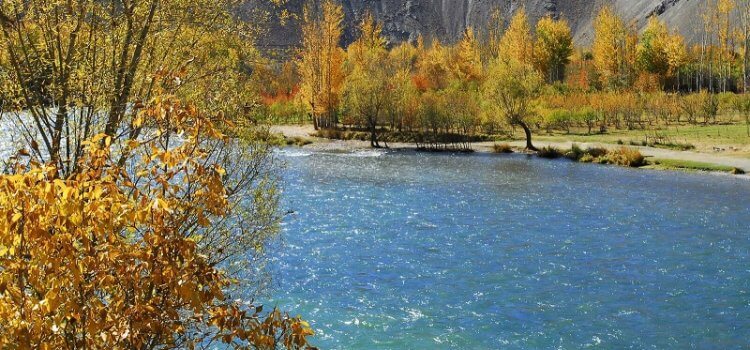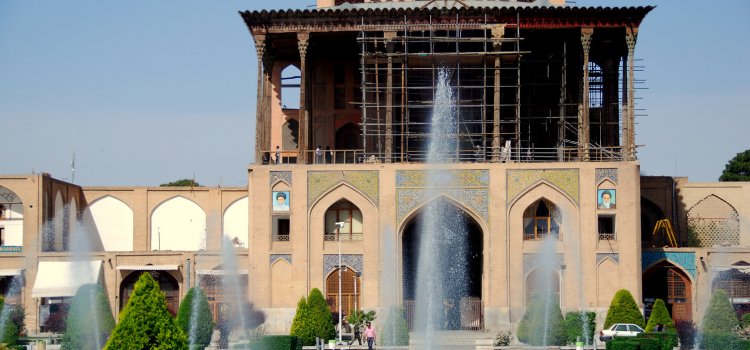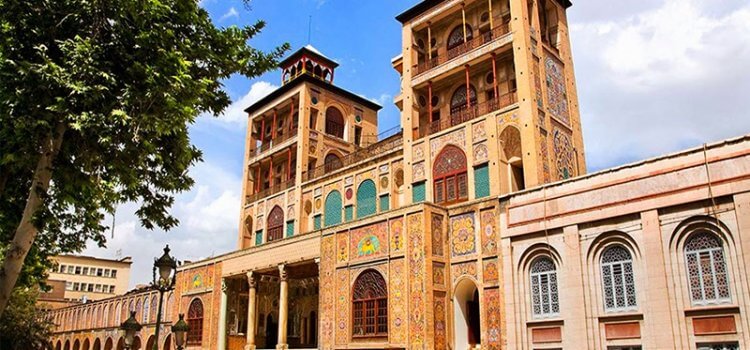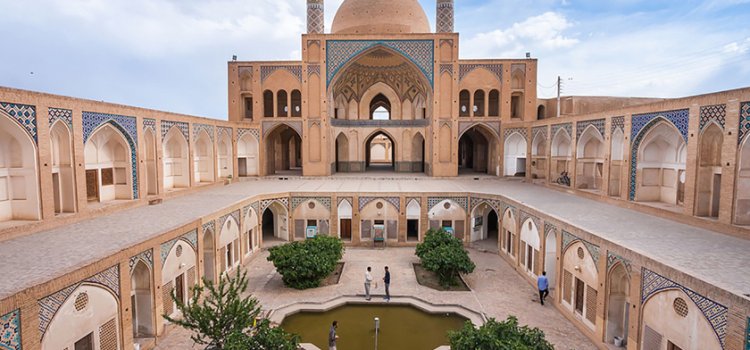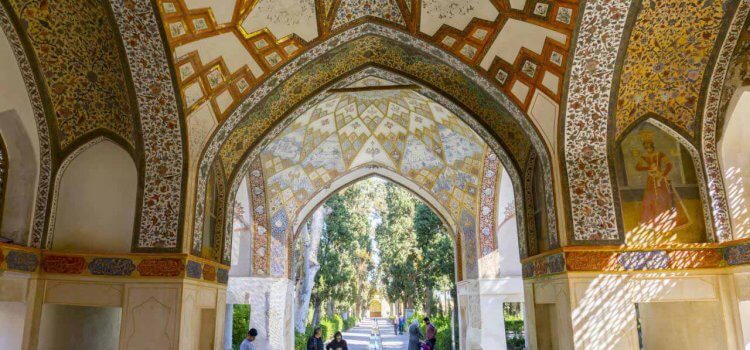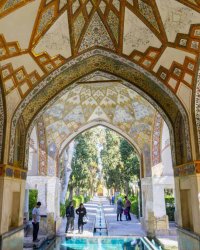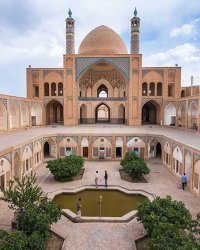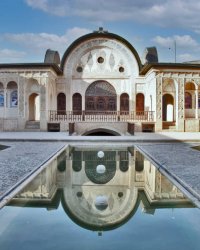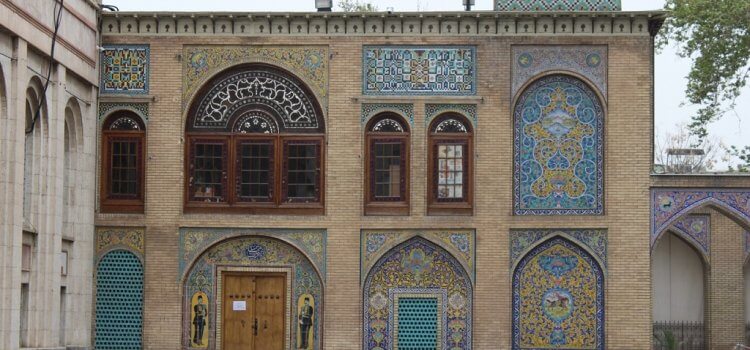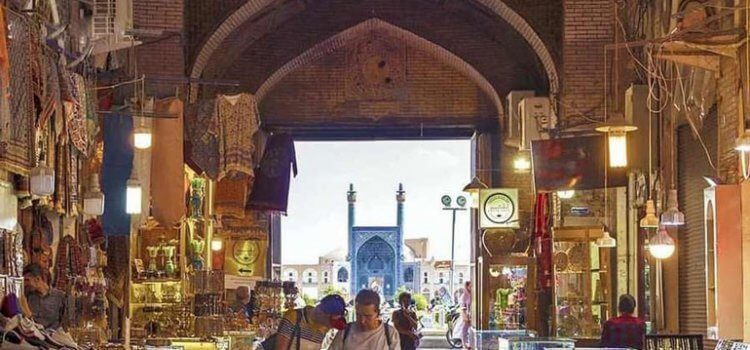Zayandeh Rud The Throbbing Heart of Isfahan
Zayandeh Rud, alternatively spelled as Zayande Rud or Zayande(h) Rood, is one of the most important rivers of Iran
Zayandeh Rud, alternatively spelled as Zayande Rud or Zayande(h) Rood, is one of the most important rivers of Iran, irrigating the lands located in the center of Iranian plateau. The river’s origin is in Kuhrang, a part of the Zard Kuh Bakhtiari Mountain range, where it flows east before disappearing in Gavkhuni Marshland. On its meandering way, it travels a distance of about 420 kilometers. At Shurab Village in the Tange Gazi district, several springs and rivers (Dimeh, Abzari, Chamdar, Abkhorbe and Na’leshkanan) join the flowing stream of water, making what is from now on called Zayande Rud or the life-giving River. Soon, another branch streaming from Kuhrang joins Zayande Rud. Furthermore, after Tange Gazi, three other rivers come to contribute to Zayande Rud: Kagunag, Khersanak and Plaskan. After Zayande Rud Dam Lake, no other sources of water contribute to the river.
Over the history, 13 bridges were built on Zayandeh Rud: 1. Evergan Bridge, 2. Zaman Khan Bridge, 3. Kalleh Bridge, 4. Baba Mahmud Bridge, 5. Falavarjan Bridge, 6. Marnan Bridge, 7. Si-o-Se Pol, 8. Juie Bridge, 9. Khaju Bridge, 10. Shahrestan Bridge, 11. Chum Bridge, 12. Soroush Azaran Bridge, and 13. Varzaneh Bridge.
Ali Qapu Palace
Ali-Qapu Palace is another gem tourists should make sure to visit while they are in Isfahan. Ali-Qapu palace is located on the west wing of Naghsh-e Jahan Square, in front of Sheikh Lotfollah Mosque.
Ali-Qapu Palace is another gem tourists should make sure to visit while they are in Isfahan. Ali-Qapu palace is located on the west wing of Naghsh-e Jahan Square, in front of Sheikh Lotfollah Mosque.
During the Safavid period, Ali Qapu Palace served different purposes: 1. it made an intimate relationship between the royal court and the common people coming and going in the square; 2. it functioned as the entrance to the complex of royal palaces behind Naghsh-e Jahan Square.; 3. it also functioned as an official office where the royal court met and solved the problems of the country.
Before the establishment of the new Safavid square which was originally called Meydan-e Shah (Shah Square), its site was almost occupied by an older 14th-century Timurid garden known as Naghsh-e Jahan. From the time of Shah Ismail, the area had both a meydan (square) and a palace called Dowlat-Khaneh (literally The House of the Government).
When Shah Abbas’ construction campaign began in Isfahan (1592-1598), he ordered the building of the five-storey Ali-Qapu Palace at the place of the older Dowlat-Khaneh. When the added parts were completed, the first floor was also transformed to match the rest of the building. It is interesting to know that Eskandarbeig Turkman, the historian of Shah Abbas’ court, refers to Ali Qapu Palace as dargah-e panj tabaqe, or (the gateway of the five-storey building).
As P.P.Soucek argues, the name Ali Qapu gained currency after the 1643-44 addition of gateway and Talar. It is believed that the doors of the gateway were transferred from the mausoleum of Imam Ali, the first Imam of the Shia Muslims, in Najaf (now in Iraq) to Isfahan and installed at the gate of the palace. From this time onward, the mansion came to be known as Ali Qapu or the “lofty door”.
When you pass the gate of Ali Qapu, you will enter an octagonal vestibule known as Hasht Behesht (or eight paradises). This part of palace is covered with an amazingly decorated dome, flanked by guards’ rooms and certain offices.
In front of you, there is a passageway, referred to as the royal passageway, which led to the palaces behind the Ali Qapu. Just after the vestibule, on your left, there is small a door which you should enter and take the steep stairs leading to the different floors and rooms of the Safavid mansion.
Generally, each floor of Ali-Qapu Palace includes a music room, a royal chamber and several banqueting rooms. All these rooms were centered around a large room, serving as the reception hall. Obviously, the king used to receive his high-ranking guests in these rooms.
To boast the grandeur of the court, all the 52 rooms of Ali Qapu Palace were decorated as majestically as possible: very delicate and highly priced rugs covered parts of the walls, while other parts were painted with incredibly beautiful frescos, representing a balanced, harmonious combination of floral designs, birds and European scenes. The curtains hung over the windows were of gold and silk fabric.
Following the steps takes you to the talar or the columned balcony of Ali Qapu Palace, built by the order of Shah Abbas II in 1648. This one of a type balcony, masterminded by the grand vizier of the king Saro Taqi, includes 18 columns, each one a 10-meter high trunk of a single plane tree. These 18 columns support a double-layered ceiling, embellished with fine inlaid work and frescos. In the middle of the terrace, there is a marble pond, its surface covered with copper. The king and his guests used to sit in this balcony while listening to the melodious flow of water in the pond and being entertained by celebrations, marches, local plays and even games of polo in the Naghsh-e Jahan Square below. And now that you have reached this royal balcony, we bet you would enjoy one of the most beautiful scenes you have ever seen in your life, a breath-taking panoramic view of the Naghsh-e Jahan Square.
Behind the columned terrace, there is Shah Abbas’ throne hall, used to receive royal guests. In comparison with other rooms, it is much larger, decorated with delicate stucco work, called lāyeh-chini, and fine frescos representing scenes similar to paintings in other rooms. These paintings were the work of Reza Abbasi, the great Safavid painter, and his talented students.
There is an interesting point you should know about this room. If you look up, you will see the upper part of the reception hall surrounded by a series of small windows. These rooms hosted the women of harem, where they gathered to partly enjoy the celebrations held in the reception hall by peeping through the windows.
The small balcony at the back of the throne hall overlooks a politico-religious monument called Tohid Khaneh. It is a single story, twelve-sided building reflecting the Shiites’ belief in the twelve scared Imams. The balcony also houses two narrow spiral staircases of 92 steps, taking you to the highest and most beautiful floor of Ali Qapu Palace, known as the Music Hall.
The Music Hall is also a late addition from the time of Shah Abbas II. It is decorated lavishly with the most beautiful patterns and fretwork stalactites, which are made of hollow pendentives of 20 different patterns. The reason this room is called Music Hall is because of the acoustic properties of these pendentives, which make this hall the most suitable place for performing music. The central part of the hall is cross-shaped, with an astonishingly decorated ceiling bearing stalactite squares transforming into squares. Staying in this room for a while works magic. Immerse yourself in the beauties of this hall and open your ears up to the centuries of music played here, the world will turn into a heavenly place.
Chehel Sotoun Palace
In a poem honoring the construction of the Chehel Sotoun (fourty columned) palace by the Safavid king Shah Abbas Il, Säéb Tabrizi describes the palace as the fairest of all monuments in the world.
In a poem honoring the construction of the Chehel Sotoun (fourty columned) palace by the Safavid king Shah Abbas Il, Säéb Tabrizi describes the palace as the fairest of all monuments in the world. And the description is well-deserved: the play of sun, water and mirrors, the green coolness of shadows spread across earth by tall plane trees, dazzling paintings, magnificently decorated rooms and a world of memories from the past, legendary kings all combine to make up the essence of the palace-museum of Chehel Sotoun. Read on to learn more about this gem — and UNESCO World Heritage Site.
A Brief History of Chehel Sotoun Palace
Ample water resources and its location at the heart of Iran – far removed from the influence of the Ottomans, not to mention in a privileged position vis-å-vis the Persian Gulf – made Isfahan an ideal city for Shah Abbäs to declare his capital in 1598, according to Michel M. Mazzaoui’s book on Safavid History. Yet, even before this move, a series of building campaigns, which lasted for eight years, were inaugurated in Isfahan in 1590/1 of iron will and passionate work. One of the areas which underwent construction and renewal during this period was the royal precinct of Isfahan, Extending from the Naqsh-e Jahän (image of the world) square to the Chahar Baq (four gardens) promenade. The royal precinct included the vast garden of Naqsh-e Jahän which formed the basis of the Chehel Sotoun garden and palace,
After the unstable reign of Mohammad Khodä-bandeh, Iran saw the emergence of a sharp strategist who was to bring great changes to Iran: Shah Abbäs the Great. One of Shah Abbās’ passions – during his fervent building campaigns in Isfahan – was to build gardens; a passion which would associate him with the great Achaemenid emperors and re-enforce his image as the king of Iran.
At the time, the garden of Naqsh-e Jahän was used to host audiences and royal ceremonies. To accomplish these tasks, Shāh Abbās built a pavilion, surrounded by a number of small rooms in the middle of Bāq-e Naqsh-e Jahān (Naqsh-e Jahän Garden).
The royal ceremonies had by then turned into political and cultural symbols that represented the authority of the king and, as a consequence, these changes necessitated a renewal of form in designing the royal palaces: spacious palaces were needed to hold both the king’s court and his lofty ceremonies. The key to solving this problem was a man known as Sārū Taqi (Mirza Mohammad Taqi), the grand vizier of both Shah Safi and Shih Abbās II.
Sārü Taqi combined the idea of the wooden, columned talars (porticos) of monuments in Mazandaran with the halls and palaces existing in Isfahan to solve the issue of much needed larger spaces.
With the advent of Shah Abbas II’s rule, Naghsh-e Jahan Garden underwent major reconstructions. Preserving Shah Abbas I’s pavilion as the nucleus of the new building, Shāh Abbäs Il added two porticos on the northern and southern sides of the pavilion, an adjacent wing with a large iwan (terrace) on the east and a spacious columned at the front, according to Ingeborg Lugchey-Schmeisser. After the addition of columns, the garden of Naghsh-e Jahän and the palace inside it became known as Chehel Sotoun.
In 1668, the splendid coronation of Shih Soleyman was held in the Chehel Sotoun palace. However, disaster befell the palace after the auspicious coronation: during the month of Ramadan 1707, the palace was lit with numerous lamps to commemorate the religious ritual of Shab-e Qadr. The ceremony went on normally until a curtain caught fire and the flames began to devour the wooden talar. The servants rushed to inform Shah Soltän Hosein, but he replied: “let it be! It is a misfortune that should pass.” And so, the talar burnt to ashes.
Sometime later, Shah Soltan Hossein rebuilt the talar, but darker days were vet to come. In 1722, Afghan troops arrived at Isfahan and besieged the city. After several months of hardship and famine, Shah Soltän Hosein surrendered Isfahan to the Afghans. When Mahmoud Hotaki, the leader of the Afghans, entered Isfahan he went to the Chehel Sotoun Palace, destroyed the royal throne and married the daughter of Shāh Soltān Hossein.
The story of Chehel Sotoun palace became complicated during the Qajar period in the 19th century. For some time, it was used as a workshop for the tent-makers of Masoud Mirza Zell-e Soitan, the governor of Isfahan. Later, just as his son Sārem al-Dowleh Akbar Mirza was about to destroy the whole place – he had even removed some plinths from their place — the Constitutional Revolution took place and the palace was redeemed from its fate, according to Jalal al-Din Homai’s History of Isfahan. Between the years 1906-08, known as the first period of the Constitutional Revolution, the palace was used by the Sacred National Council of Isfahan and therefore became the most important center of power in the city.
Fred Richards (1878-1932), an English painter, described the garden during the first days of Reza Shih pahlavi. He wrote: “the garden has lost its previous greenness for lack of care and nothing has survived but the trees and the pool.” As available documents show, the garden was being used as a military base at the time. Then. in 1931, the municipality of Isfahan, or Baladiye, took possession of the palace. Later, the Istituto Italiano per il Medio ed Estremo Oriente, Rome (IsMEO), came to Isfahan and renovated the palace based on its old photographs. In 1948, the museum of Chehel Sotoun palace was inaugurated. After eighteen years, in order to undertake further renovations, items in the museum were moved to the banquet hall. They were displayed in this hall for five years after which they were transferred to storerooms, and no longer displayed.
Architecture
Chehel Sotoun Palace is situated to the east of Ostandari Avenue and south of Sepah Street. The garden has three entrances: one on the northern side, one on the western side and its old, main one on the eastern side. The eastern gate, in Ostandari Street, is once again being used as the entrance to the garden. This recessed entrance is flanked by two buildings: Talar-e Teimuri and Jobbeh khäneh.
Behind th’S gate lies the garden and palace ofChehel Sotoun_ The garden is rectangular with an area of about 67,000 square meters. Stretching from east to west, the garden is divided into two halves: one to the north and one to the south. On the eastern side of the garden, fronting the pavilion, there is a long pool, 110 m long and 16 m wide. At each of the four corners of the pool, four statues are displayed; each one a figural group including four angels (symbols of protection) and four lions’ heads (symbols of power), which were brought from the Safavid Sar-Pooshideh (roofed) Pavilion. This pool, as Ingeborg Luschey-Schmeisser explains: “helps to integrate the palace with the garden and extends it visually.”
The pavilion is situated in the western third of the garden and stands on a rectangular stone platform, The talar includes three rows of six polygonal columns, each made of a plane-tree trunk with a height of 13.05 m. These columns are adorned with muqarnas (stalactite) capitals and stone bases. In the 17th century, the traveler Jean Chardin described the columns as ‘turned and gilded’ and the explorer Engelbert Kaernpfer reported them as blue and gold, but the Carmelite bishop Barnabas told of the shafts as “covered with pieces of looking-glass” in the 18th century.
The eighteen columns of the talar and the two columns of the Shah-neshin (king’s room) make up twenty columns together. When these twenty columns are reflected in the long pool in front of the pavilion, the number of columns appears to be forty. It is believed that this is why the palace and garden bear the title “Chehel Sotoun” that means “forty Columned’. The true reason, however, is that forty is both a sacred number and a number that signifies abundance in Persian culture, and that is why Safavid kings chose this appellation for their royal palace and garden.
Two further columns, two wooden balustrades and a slight elevation separate the columned talar (from the adjacent hall, which is sometimes called the Mirror Hall, or Shah-neshin). The hall is formed by two flanking rooms and a further elevation, which divides it in two parts. In the middle of the first half of the Shah-neshin, there used to be a three-tiered marble pool. The wooden ceiling, above the previous pool, is decorated with a chequered panel, inlaid with mirrors of various sizes. The second half of the Shah-neshin houses the throne platform. The ceiling above the throne platform displays decorative muqarnas, filled with mirror work are attributed to this fresco outlined in fine golden lines. From a dado, half way up, the walls are also covered with mirror work.
The banquet Hall is a spacious rectangular room, flanked by two-storey rooms at each corner. The most striking feature of this wall is its wall-paintings, which narrate stories of power, glory, humiliation and love.
To the west of Banquet Hall, there is portico identical to the Shah-neshin on the eastern side of the hall. The portico is embellished with muqarnas decorations and delicate stucco work. Fine miniatures adorn this iwan and its flanking rooms, too.
Wall-Paintings
The walls of the banquet hall are divided into three zones: from the ground up to an eye-level dado: the main decorated zone above this; and, finally, the upper zone. The most eye-catching wall paintings in this hall are the four frescos and the two Ghahve khanei (coffee-house) paintings in the upper zone.
Below these paintings, in the main decorated zone, there is a band of other smaller wall paintings. Representing courtly picnics with few figures, these paintings date to the middle of 17th century. As Sussan Babaie points out: “there must have been a dado faced with painted walls, almost overwhelmed by the powerful paintings of the wall niches.”
The rooms flanking the banquet hall are also covered with frescos from the Safavid era; these were discovered under a coat of whitewash, which was applied to them in the Qäjär period. In these rooms, only two paintings represent landscapes, birds, trees and deer. In the northeastern room, off the banquet hall, there are some frescos representing Shah Abbas and his I and his retinue in the open air and in other courtly settings, celebrating and enjoying themselves. In a symmetrical room on the other side of the hall, which is called Chahar Shanbeh Suri (an ancient Iranian feast celebrating the last Wednesday before Nowruz), there is a fresco which gives its name to the room.
Two stories are attributed to this fresco: one story claims that it depicts the wedding ceremony of Reza Qoli, son of Nader Shah Afshar, to an Indian girl; the other connects it the painting to a tragic historical event in which a girl set herself on fire after the siege of Bukhara by Shah Abbas II. There are also scenes inspired by Persian love poetry: Khosrow and Shirin by Nizami Ganjavi and Yusof and Zoleikha.
In the Garden of Chehl Sotoun there are further other objects from the Safavid period; such as portals, inscriptions and tile work from the Qotbiyeh, darb-e Jubareh, Pir-e Pinehduz and Darb-Kooshk mosques, installed on the Western and Southern walls of the garden.
Shamsol Emāreh
Based on the available documents, construction of Shamsol Emareh started in 1866 and lasted two years.
Based on the available documents, construction of Shamsol Emareh started in 1866 and lasted two years. Designed by Moayer Al-Mamölek and built by Ali Mohammad Kashi, this five-storey high building was meant to stand out against the backdrop of one-storey buildings ot Tehran and was. thus. named Shamsol Emareh, meaning “the sun of all buildings.” Besides its height, Shamsol Emāreh was also the first building in Iran to be constructed with iron girders. Its other notable feature is the clock tower, located in the middle of the upper floor facade. The clock was a gift to Naser al-Din Shah from Queen Victoria of England.
The fifth floor of Shamsol Emāreh was known as Kolah Farangi. From there, using simple binoculars, the king ‘s wives could enjoy a panoramic view of the city and the Alborz Mountains.
According to historical records, on the inaugural day of Shamsol Emareh, a royal commander, general Mirza Hossein Khan, whispered ill-tended words into the ears of Naser al-Din Shah that the royal treasury had to take full responsibility for the construction expenses of the monument. General Doost Ali Khan Moayer al-Mamalek, passing by the very same moment, pledged to the Shah to personally take care of the expenses.
Agha Bozorg Mosque
As the name indicates here we are dealing with a multi-function structure which is pretty and unique construction of its kind:
Agha-Bozorg School-Mosque
As the name indicates here we are dealing with a multi-function structure which is pretty and unique construction of its kind:
A modest entrance with typical 19 century painted tiles and a door with 6666 rivets hinting to the number of Quran verses;
An open corridor leading to the main dome chamber without any decoration. Downstairs an interior courtyard is accommodated by students.
Do not look for an elegant mihrab The mihrab is a hidden dent behind the pillas. This reveals a truth, the mosque is not in line with the direction of Mecca and therefore fell to the disgrace of Public shortly after its construction.
Fin Garden
Fin Garden is a good example of Iranian gardens, water source irrigates the garden and goes down towards the city.
Fin Garden is a good example of Iranian gardens, water source irrigates the garden and goes down towards the city.
Old cypresses are numerous. in the middle of the central pavilion a basin is located, here is one of the sources debouches in the garden.
more spectacular are water jets which work by natural water pressure due to ingenious hydraulic rules.
this garden remains in Iranian thoughts because of the assassinates of Amir Kabir a grand Minister in 19 century, a great hero of Iranian history.
kashan
Kashan is the ancient oasis of the central plateau. Its history, thanks to the archaeological mounds of Sialk, dates back to time immemorial.
Its name recalls the tiles in Persian, but the city is famous for its rose gardens, and of course the distillation of rose water, with its annual festival.
In the 19th century, its hand-woven rugs exported the Kashan’s fame artistic through the world.
The city has suffered from so many climate changes and the loss of the carpet market, the basis of its industry, over the past decades.
Due to this economic and geographic desertification, the city experienced waves of migration to other major metropolitans like Tehran and Isfahan, but the city has been able to react thanks to the resumption of tourism.
Hundreds of old houses transformed into boutique hotels welcoming their guests.
The fact that the city is located on the north-south axis, makes it an ideal overnight stopover and fits well in tourist trip plans.
The Fin garden offers the visit of a typical Persian garden, with its vegetation and its architecture.
The sad tragedy of the murder of Grand Vizier Amir-Kabir, one of the heroes of Iranian history, took place in the depth of his bath.
Take the time to climb on the roof of the Seraglio of Amin-o-doleh in the bazaar where you can admire the sunset.
Can you leave Iran without visiting Kashan?
Located on the edge of Kavir desert, with hot summers and cold winters, and a population of only 329,000, Kashan may noy seem to you as a must-see attraction at first glance. However, this seemingly unimportant town has always been comparable to the biggest cities of Iran during its history. Let us have a look at Kashan’s history to see why you should take a Kashan City Tour.
Four kilometers to the west of Kashan, there lies a mound, or better to say a series of mounds, generally referred to as Tappeh Sialk. Many archeologists believe that these mounds hold the relics of the ancient city of Sialk, a town inhabited by a civilized people from the 4th millennium BC or even earlier, which makes Kashan one of the most ancient sites of civilization on the Iranian plateau.
Furthermore, the presence of a fire temple and a Mithraic cave, called Rais Cave, in the nearby town of Niāsar are confessions to the importance of the region during the pre-Islamic Sassanid era (224 to 651 AD).
No wonder, this long, long history has given birth to many exotic stories, breathing a mythic spirit into the old alleys of Kashan. One such story claims “the three Wise Men,” those well-known ones who attended the birth of Christ, departed from Kashan to Bethlehem to meet the newly born son of God.
Or, take the odd story of the Arab conquest of the city in the 7th century. According to legend, as the troop of Islam, led by Abu Musa al-Ash’ari, arrived at the gates of Kashan city, they found the fortifications of the city insurmountable. Finally, after rounds of heated discussion, the generals came to the conclusion that they had to throw scorpions into the city to bring people of Kashan to their knees. And that’s how various historians during history have accounted for the abundance of scorpions in Kashan, a city which was once famous for its deadly scorpions. But DO NOT PANIC! There is no trace of those scorpions in the city any more.
By the way, after Islam, Kashan came under the jurisprudence of Isfahan governors. Yet, this didn’t prevent various tribes from attacking the city until Zobeida, the favorite wife of the Caliph Harun al-Rashid, ordered the construction of new fortifications around the city. Sad to say, these structures were ruined by two earthquakes in 854 and 857 AC.
However, Kashan began to transform from an agricultural township into an urban center under the Buyid rule (9th century). Although Buyids did their best to rebuild the city, Kashan was hit by another devastating earthquake in 957 AC. Adding fuel to fire, a violent epidemic which followed next year practically eliminated the city.
Despite all these unfortunate events, the process of rebuilding the city continued well into the second half of 11th century, when Kashan gained importance as a military gateway to Isfahan and a Saljuk capital. During the Saljuk rule (12th century), the old congregational mosque of the city from the Buyid period (known today as Masjed-e Jameh or Masjed-e Kohneh), and also canals and dykes for the management of water were renovated. In addition, a city wall with eight towers and two gates were built around the city (today, you can visit the remains of this city wall, plus a fortress, known as Jalali Castle, and two ice houses, at the end of Alavi Street). By 1500, Kashan was the most important town in the region after Isfahan.
Years later, the coronation of King Ismail I in Fin Garden invested Kashan with a quasi-holy aura which absorbed the respect and attention of almost all the Safavid kings. Furthermore, Shah Tahmāsb, the second Safavid king, invited an influential theologian, Mohaqqeq Korki, to come and reside in the city. This move turned Kashan into an important religious city, winning it the title of Dar al-Momenin or the House of the Faithful. And it is one of the reasons that Shah Abbas I, the greatest Safavid king, was buried in Habib Ibn Musa Shrine in this city.
The Safavid period was the period when the production of handicrafts in Kashan reached its peak. At this time, Kashan’s workshops produced the best quality carpets, velvets, glazed pottery and tiles in the country. It is interesting to know that the name of tile in Farsi, Kāshi, comes from the name of Kashan.
At the beginning of Qajar period, Agha Mohammad Khan, the founder of Qajar dynasty, razed part of the city and killed many of its citizens. But, after a while, the peace came back to the city and it began to prosper once more.
Kashan was once well-known for its carpets and tiles, but nowadays many people rush to visit this city because of its exemplary traditional Iranian houses. With a special architectural structure unique to desert houses known as Gowdal Baghche, fine stucco, colorful sash-windows, amazing mirror-work and vivacious paintings, these houses provide you with the best examples of private residences in Iran during the Qajar period. We can mention Tabatabaei House, Boroujerdi House and Abbasian House as most famous of them, located in Sultan Mir Ahmad Neighborhood, one of the oldest neighborhoods in Kashan in Alavi Street.
While still in Sultan Mir Ahmad Neighborhood, you can also visit Sultan Mir Ahmad Shrine which lends its name to the whole neighborhood. Then, you can go to have a look at Sultan Mir Ahmad bath, a 500-year-old Iranian hammam. The rooftop of Sultan Mir Ahmad Bath provides you with a panoramic view of Kashan and the best place to take fantastic photos for your Instagram.
Also, you shouldn’t miss the historic bazaar of Kashan, a trade center for about 800 years. The bazaar is busy but not hectic, lined with old-fashioned shops filled with goods that you can only find in a traditional bazaar. Do not forget to spend some time in Saray-e Amin al-Dowleh, which its unique architecture and cozy atmosphere would mesmerize you.
Masjed-e Soltani and Masjed-e Mir Ahmad are among the notable mosques you can visit in Kashan. But we strongly suggest visiting Aqa Bozorg Mosque whose two-storey structure, simple yet awe-inspiring brickwork and delicate inscriptions make this Qajarid mosque one of the most visited sights in Iran.
Finally, to relax after a long day in Kashan, we invite you to visit the grand Fin Garden. Its marvelous Safavid pavilion, surround by tall cedar trees, turquoise-colored ponds and water streams and also other smaller pavilions from the Zand and Qajar eras, with paintings narrating old Iranian tales, turn this garden into a World Heritage Site the epitome of the world-known Persian gardens. And if you are interested in historical stories of political betrayal and murder, dedicate some time to exploring the bath of Fin Garden. There, the veins of Amir Kabir, the grand prime minister of Naser al-Din Shah and one of the greatest political activists who radically changed the face of Iran, were split. He bled to death in the bath of Fin Garden, as a result of a conspiracy against him, led by Mahd-e Oliya, the mother of the king, and all the princes and princesses who could not tolerate the fundamental changes that Amir Kabir imposed on their lifestyle.
However, Kashan in not just history, art and architecture. If you attend Kashan in spring, you would be able to participate in the festival of Golab-giri, a ceremony in which rose flowers are collected, boiled and turned into a fragrant liquid, known as Golab, used as perfume or in cooking different foods and sweets.
Finally, whenever you feel hungry, you can try any of these local dishes of Kashan: Jujui Tas Kabab, Kateh Moatar, Khoresht Nokhod Alleh, Sumac Kufta, Chickpeas Kufta, Eggplant Kufta, Meat and Beans, and Quince Stew.
So, if you are curious to visit this ancient city of culture, art, architecture, nature and mouth-watering dishes, do not hesitate to book your Kashan City Tour with us at Irandelle Travel Agency.
The Wind-Tower Building
The Wind-Tower Building, built by the order of Fat’h Ali Shah in 1806, is surrounded by the most attractive places in the Golestan Palace.
The Wind-Tower Building, built by the order of Fat’h Ali Shah in 1806, is surrounded by the most attractive places in the Golestan Palace. The majestic monument is decorated using a variety of architectural art techniques including mirrors. incrustation, gilding, wood carving, etc. Sash windows installed in this building are characteristic of Iranian architecture.
The most conspicuous element of the building, however, is its four wind-towers trapping the wind and channelling it to Howz-Khaneh in the basement and then funnelling the cooled air back into the interior spaces. This ingenuity would ensure the flow of pleasant air inside the interior spaces. There have also been numerous stories associated with the Wind Tower Building. It is said that once, when Tehran was experiencing one of its hottest summers and Mozafar al-Din Shah was getting for his coronation, a decision was made to hold the coronation in this tower to escape the scorching heat.
Furthermore, Kamal al-Molk resided in this building for a while. During the rule of Mohammad Reza Pahlavi, it was used as the royal library. According to Moayer al-Molk, beautiful birds of different species were kept around the pool in the basement of the building. Presently, Howz Khaneh houses a photo-gallery, whose many photos were taken by Naser al-Din Shah himself.
Qeysarie Bazaar
Qeysarie Bazaar, also known as the Royal Bazaar or the Grand Bazaar of Isfahan, is located on the northern side of the Naghsh-e Jahan Square.
Qeysarie Bazaar, The Grand Bazaar of Isfahan
Qeysarie Bazaar, also known as the Royal Bazaar or the Grand Bazaar of Isfahan, is located on the northern side of the Naghsh-e Jahan Square. It is one of the first constructions built in the Naghsh-e Jahan Square, completed in 1605 AC.
The majestic entrance of the Qeysaie Bazaar (completed in 1617 AC) is decorated with eye-catching faience mosaic work. The spandrels are decorated with the image of a mythic creature: a being composed of a human head and a tiger body, shooting its dragon tail. Actually, the mythic symbol represents the ninth astrological, known as Sagittarius. Historians believe that Isfahan was founded in the ninth of the year, and that is why it appears on the spandrels at the top of the Qeysarie Gate.
In the middle of the portal, there are three frescos: the one on the west represents Shah Abbas hunting, the one in the middle shows Shah Abbas fighting the Uzbeks and the third one, on the east, demonstrates Europeans in the Safavid court. Below this frescos, there is a window which once was part of a Sharbat-sara (literally “syrup house”), where the king and his guests used to gather to drink and enjoy the eye-catching view of the Naghsh-e Jahan Square. Nowadays, this building has turned into a museum in which you can enjoy the works of modern Iranian artists. Also, it includes a tea-house, on the roof of the Bazaar, where you can sit, order a drink and enjoy the view of the square.
Flanking Qeysarie’s portal, there were two structures called Naqāreh-Khāneh (Timpani House), used to announce the time at dawn and sunset by playing trumpets and also timpani. Of these structures, there is no trace today.
The Qeysarie Bazaar itself includes a large number of roofed lanes, all lined with shops or hojrehs. At special intervals, usually four lanes meet and make a chahār-sūq. These chahār-sūqs are usually covered with a brick dome and function roughly as a crossroad or square, connecting different parts of the Qeysarie Bazaar together.
In addition to the main corridors, Qeysarie Bazaar is marked by different Saraas, Timchehs and Caravanserais which mostly hold workshops, storehouses and offices of some Bazaaris or merchants working in the bazaar. We strongly advise you to visit Timche Malek, a lavishly decorated Qajar-era building in the Bazaar.
All in all, the Qeysarie Bazaar makes an attraction which every traveler coming to Isfahan should make sure to visit. It is one of the biggest and most splendid bazaars in Iran, providing you with all types of Iran’s souvenirs. As you cross one lane, the fragrance of high-quality spices revitalizes your soul; another lane invites you to feast your eyes on the colorful designs of world-quality carpets; and in other lanes you will come across such beautiful handicrafts the examples of which you cannot find anywhere else in the world. Most important of all, the Qeysarie Bazaar is one of the best places where you can make connections with the local people and immerse yourself in the thousands-year-old culture of Isfahanian people.
Qeysarie Bazaar, also known as the Royal Bazaar or the Grand Bazaar of Isfahan, is located on the northern side of the Naghsh-e Jahan Square.
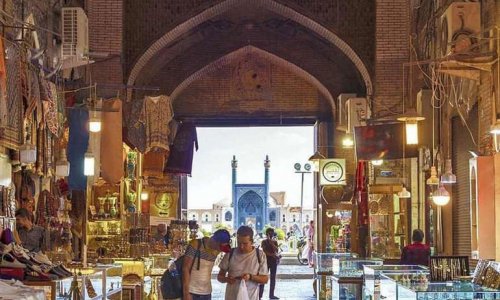
Bushehr
Bushehr
Bushehr
Bushehr is a port city on the Persian Gulf, south-western Iran. It is built near the ancient port city of Rishahr (Sassanian, Riv Ardasher). Its location is about 1,218 kilometres south of Tehran.
Bushehr was the main trade center of Iran in the past centuries. The city structures are traditional in style, modest in proportion and cost. Due to its lack of rail connection to the interior of the country and its shallow anchorage, it has lost its position as the primary port of Iran.
Bushehr is one of the important ports in Persian Gulf which has an international airport, and highways connect the city to Ahvaz to the northwest and Shiraz to the northeast. A secondary coastal road links Bushehr to Bandar-e Abbas to the southeast. The old section of central Bushehr has many examples of traditional Persian Gulf architecture from the period 1870 to 1920.
Bushehr is an export market for the farm produce of the neighboring and fertile Fars Province. Bushehr’s industries include seafood canneries, food-processing plants, and engineering firms. It has a population of 205,320 (2001 estimate).

